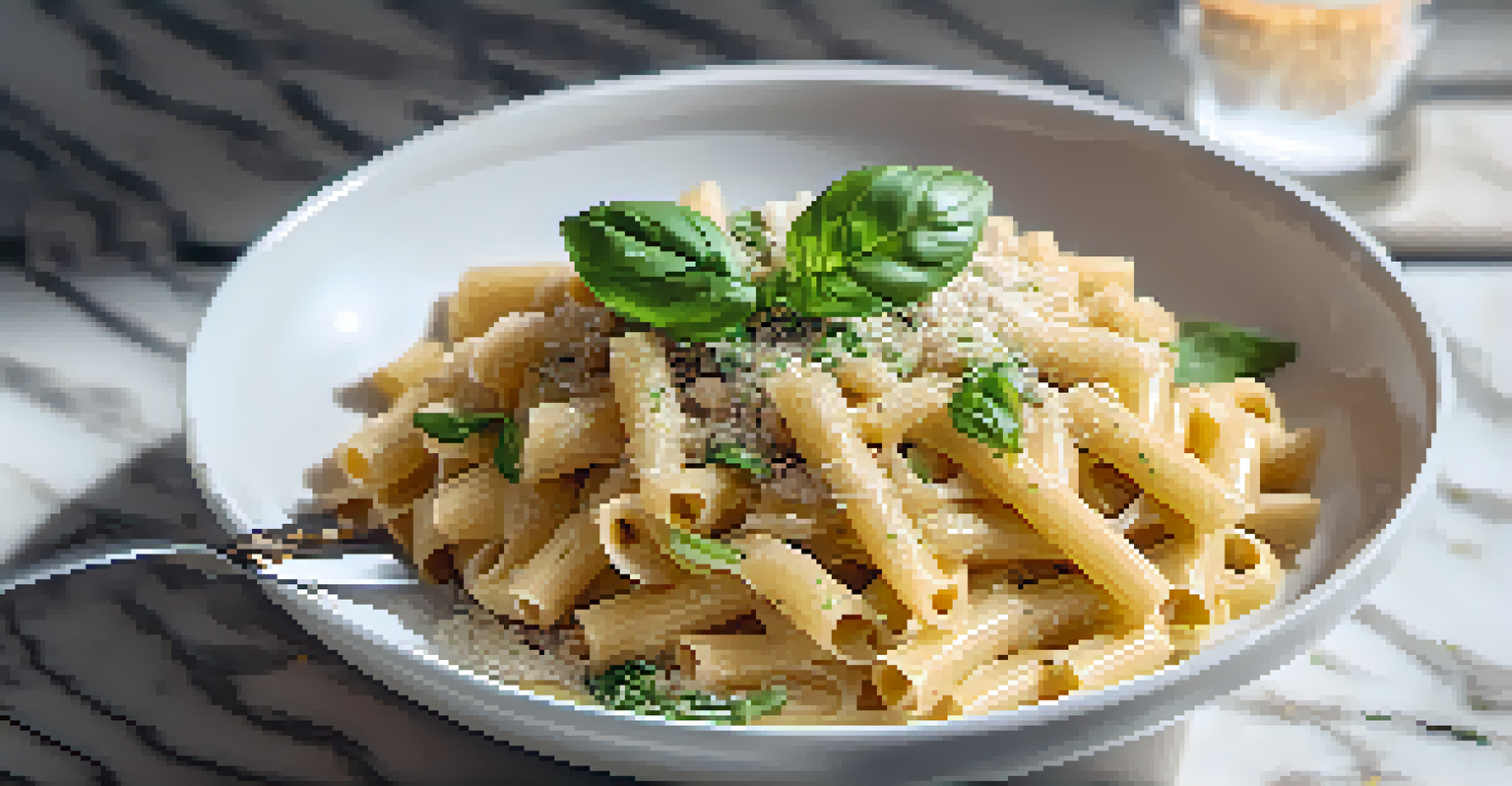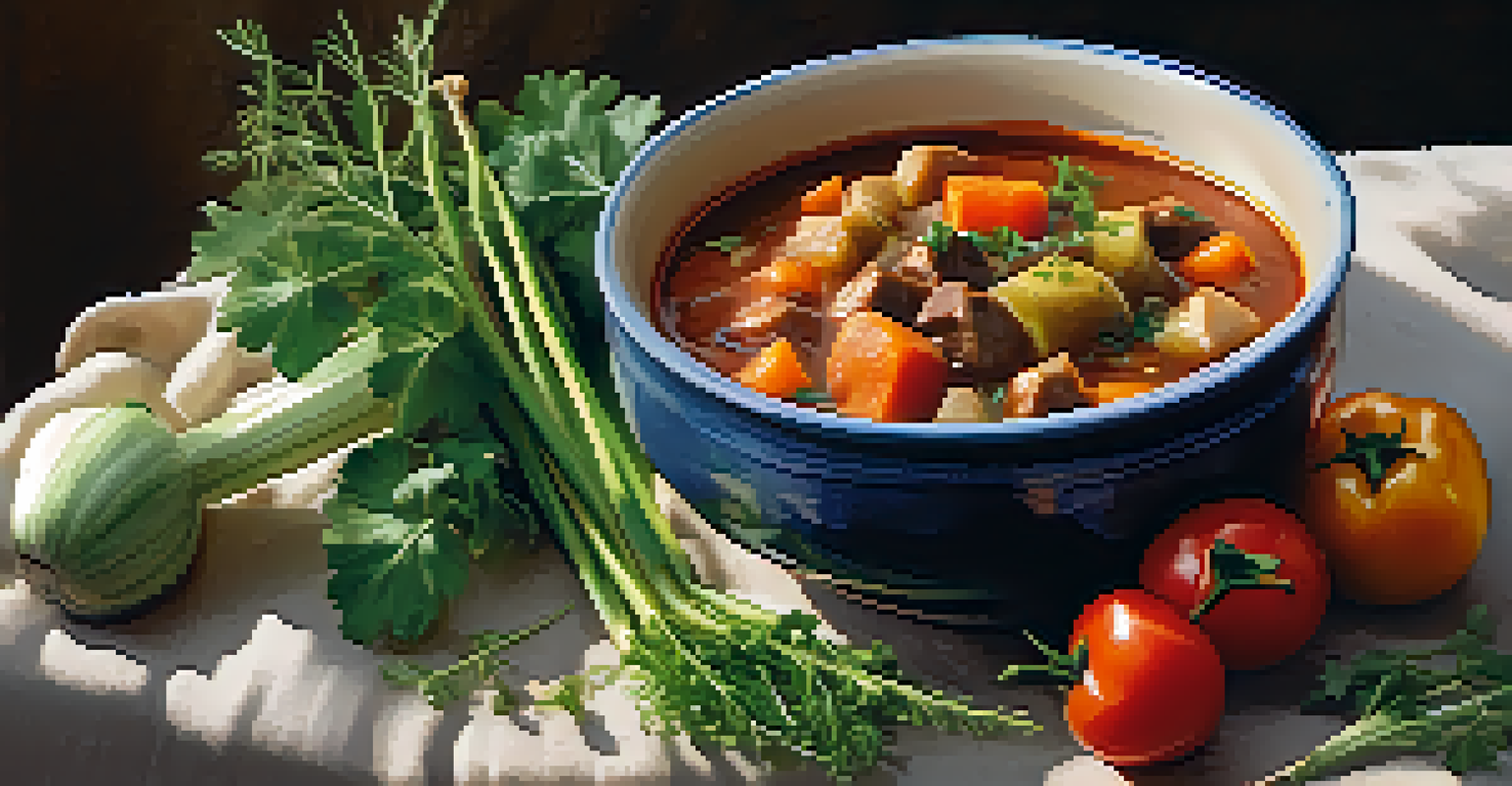Choosing the Right Background for Vegan Food Photos

Understanding the Role of Backgrounds in Food Photography
When it comes to food photography, the background plays a crucial role in how the dish is perceived. A well-chosen backdrop can enhance the colors and textures of your vegan creations, making them more appealing to viewers. Think of the background as the stage for your food; it should support the main act without stealing the spotlight.
You don’t take a photograph, you make it.
For vegan food, backgrounds can either contrast or complement the vibrant colors of fruits and vegetables. A neutral background can help the greens pop, while a rustic wooden surface may bring out earthy tones. The key is to choose a background that aligns with the mood you want to convey.
Remember, the right background doesn’t just enhance aesthetics; it tells a story about the dish. Whether you want to highlight freshness or comfort, the backdrop should reflect the essence of your vegan food.
Choosing Colors that Enhance Vegan Dishes
Color theory is an essential tool in food photography, especially for vegan dishes that boast a rainbow of hues. Colors can evoke emotions and set the overall tone of your photo. For instance, a bright white background can create a clean, fresh look, while rich, dark colors can evoke a sense of warmth and earthiness.

Consider the colors of the ingredients you’re using. If you have a vibrant salad, a muted background can prevent the image from being overwhelming. Conversely, if your dish is more subdued, a pop of color in the background can create visual interest and draw the eye.
Backgrounds Enhance Food Appeal
A well-chosen background can elevate the colors and textures of vegan dishes, making them more visually appealing.
Ultimately, the goal is to create a harmonious image where the food takes center stage. Experimenting with different color combinations can lead to stunning results and help you find the perfect balance.
Textures: Adding Depth to Your Food Photos
Texture can transform a simple food photo into a captivating image. When choosing a background, think about how the surface will interact with your vegan food. A textured background, like a linen tablecloth or a wooden board, can add depth and dimension to your shots.
The best camera is the one you have with you.
For example, a rough stone surface might pair beautifully with a creamy vegan pasta, adding contrast that enhances the dish's creaminess. Alternatively, a smooth marble surface can give a more elegant feel, perfect for a sophisticated dessert.
Don’t be afraid to mix and match textures. Combining different surfaces can create an intriguing backdrop that draws the viewer's eye and adds layers to your composition.
Natural vs. Artificial Backgrounds: What Works Best?
Choosing between natural and artificial backgrounds can significantly affect the feel of your vegan food photos. Natural backgrounds, like a garden or a wooden table, often convey a sense of freshness and authenticity, which can resonate well with vegan cuisine.
On the other hand, artificial backgrounds, such as colorful paper or fabric, can provide a controlled environment where you can manipulate colors and textures to your liking. This approach allows for more creativity, especially when trying to evoke a specific mood or theme.
Lighting Brings Food to Life
Natural light and proper lighting techniques are essential for highlighting the beauty of vegan cuisine in photography.
Ultimately, the choice depends on the story you wish to tell with your food. Experimenting with both types can help you discover what resonates best with your audience.
Lighting: The Unsung Hero of Food Photography
While the background sets the stage, lighting is the unsung hero that brings your vegan dishes to life. Natural light, especially during the golden hour, can create stunning images with soft shadows and highlights that make food look irresistible. Positioning your setup near a window can provide that perfect light.
If you’re shooting indoors, consider using reflectors to bounce light onto the dish, ensuring that your food is evenly lit. This technique can help minimize harsh shadows and highlight the textures and colors of your vegan ingredients.
In contrast, artificial lighting allows for greater control, especially in low-light situations. Using softboxes or LED lights can help mimic natural light, making your vegan dishes look just as appetizing.
Storytelling Through Your Background Choices
Every dish has a story, and your background can help tell it. For instance, if you're photographing a hearty vegan stew, a rustic kitchen backdrop can evoke feelings of comfort and home. On the other hand, a sleek, modern backdrop can communicate a sense of sophistication and innovation.
Think about the emotions you want your audience to feel. A vibrant, lively background might work well for a fresh, zesty salad, while a muted, cozy setting could be perfect for a warm vegan curry. The background sets the narrative, guiding viewers to engage with the dish on a deeper level.
Storytelling Through Visual Choices
The background of your food photos can convey a story, evoking specific emotions that resonate with viewers.
By carefully curating your backgrounds, you can create a cohesive visual story that resonates with your audience and showcases the beauty of vegan cuisine.
Practical Tips for Setting Up Your Food Photography Space
Creating an inviting food photography space doesn’t have to be complicated. Start by decluttering your area, ensuring that only elements that enhance your composition are present. This helps the focus remain on your vegan dishes without distractions.
Investing in a few versatile backgrounds, such as neutral boards or colored fabrics, can make it easy to switch up your setup. Having a designated space with good natural light can also streamline your process, allowing for quick and efficient shoots.

Lastly, don’t forget to experiment! Sometimes the most unexpected setups yield the best results. Keep trying different backgrounds and arrangements to discover what works best for your vegan food photography.
Editing Your Photos for the Final Touch
After capturing your vegan food photos, editing can elevate your images to the next level. Simple adjustments to brightness, contrast, and saturation can enhance the colors of your dish and the background, making everything pop beautifully. Software like Lightroom or even mobile apps can be great for quick edits.
Consider the overall mood you want to convey. If you’re going for a bright, fresh look, increasing exposure might be beneficial. Conversely, if you want a cozy vibe, warming up the tones can make a significant difference.
Remember, editing should enhance the story you’re telling with your food, not overshadow it. Make subtle adjustments to maintain the authenticity of your vegan creations while ensuring they stand out.